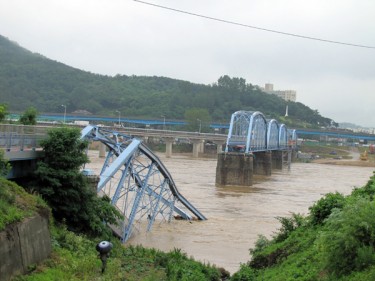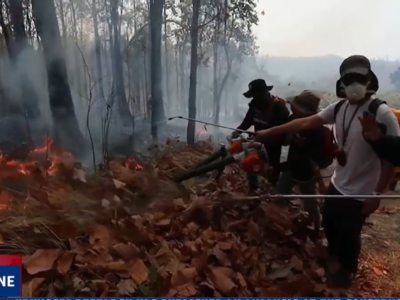A typhoon hit South Korea on June 25 and 26, 2011, bringing heavy downpours and gusts and signalling the start of the rainy season. At least nine people were killed and a bridge and a levee collapsed. Moreover, a leakage was reported on a landfill where livestock was buried during the foot-and-mouth disease outbreak.
The rainy season is from late June to early July in Korea and about two more typhoons are expected to pass the Korean peninsula. Though typhoon ‘Meari’ of June 26 has managed to disrupt few places, people have voiced concerns that this typhoon is merely a premonition of unfolding disasters in a country where several hundred landfills are perched near a river and rivers are unstable due to the government's river project.
Environmental damage
The mass killing of livestock to slow down the foot-and-mouth disease (FMD) started in December 2010. A quarter of the country's cattle and numerous pigs and ducks were killed and some dumped alive, creating several hundred landfills as a result.
From the start, more than a few experts have predicted that toxic elements from the landfill may leak during the monsoon season. Indeed on June 24, landfill leachate was flooded during the torrential downpour. South Korea's progressive newspaper, Hangyoreh reported [ko] that it could contaminate nearby groundwater. Twitterer @oooiooii who heads a vegetarian community tweeted [ko]:
장맛비에 ‘구제역 침출수’ 샜다 http://durl.me/b3jzg 염려하던 일이 드디어 현실로 나타나는구나
TV writer @borabay criticized [ko] the government for not taking actual measures.
구제역 매몰지 ‘비상’ 곳곳 무방비상태. – 예견은 했으면서도 요행을 바란 것. ‘견디겠지 뭐.’ […]
Yoon Gun (@theyoongun) tweeted [ko]
구제역..생명을 우습게 다룬 댓가..그리고 저주..장마가 오니.. bit.ly/mAsIZz
To many, the image of dead animals flooding from the landfill reminds them of a zombie movie. Jun Young-hwan (@junyounghwan) tweeted [ko]:
[…]공포영화 시나리오 하나 떠올랐다 구제역으로 죽은 돼지와 소들이 장마때 갑자기 땅속에서 나와 사람들을 잡아먹기 시작하는 영화 무능력한 정부와 사람들의 갈등을 양념으로 풍자와 유머가 있으면 나름 먹힐지도?
River revenge
Collapse of one monumental bridge during the typhoon has sparked accusations about the government's ‘Four Major River Project‘. The Four Major Rivers Project which proclaims itself a multi-purpose green growth project on four major rivers is now highly unpopular among the Korean public for both financial and environmental reasons. A total of 22.2 trillion won (near USD 17.3 billion) is officially earmarked for the project and the re-channeling or straigthening of rivers and streams has drawn intense criticism.
The Hoguk Bridge collapsed on June 25. The bridge was the last defense line on the Nakdong River during the Korean War. The fact that this symbol of national defense collapsed on June 25, the exact date the Korean War broke out, panicked people.
Local residents and South Korean Twitterers blamed the government for pushing the river project despite concerns and the project's excessive dredging work. According to a local report, excessive dredging on one side may have weakened the base of the bridge and heightened water pressure.
Many stressed that this incident is a man-made disaster since the the bridge had endured stronger typhoons and intense monsoons over several decades.
A poet Jun Nam-jin (@jinmadang) tweeted [ko]:
제 기억으로 교각이 붕괴된 곳은 <소>가 있어 수심이 깊은 곳입니다. 반대편엔 퇴적이 이루어지던 곳이죠. 소가 있는 부분은 물이 불어나면 유속이 빨라지죠. 그런 곳을 보강하지 않았으니 4대강사업이 얼마나 졸속으로 이루어지고 있는지 알 수 있네요.
While most Twitterers blamed the river project, some people took a more careful approach. JC Kwon (@ryu7566) who claims himself to be neither right nor left leaning, tweeted [ko]:
[…]KBS 뉴스에 의하면 4대강 공사업체가 다리의 기초를 깊게 팠다는군요. 근거있는 논리로 대처 해야지 감정적인 대응은 보기 좋지않네요[…]
A similar incident took place in a levee of the same river. Sang-ju reservoir's main levee which was left partly broken has severely collapsed on June 26. Opposition Democratic party member and active blogger Kim Jin-ae (@space) tweeted [ko] on the scene of the breakdown:
낙동강 상주보 본제방이 빙벽처럼 무너지고있습니다. . 너무 무섭습니다! http://twitpic.com/5h2gc7
The seasonal downpour started in South Korea on June 28 after the typhoon moved to North Korea on June 27. Net users expressed concern over the safety of the impoverished North Korean people and how would they weather devastating rains and strong winds.







